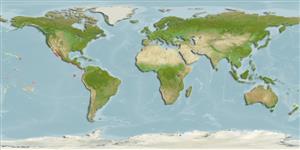分類 / Names
俗名 | 同種異名 | Catalog of Fishes(屬, 種) | ITIS | CoL | WoRMS | Cloffa
Teleostei >
Blenniiformes (Blennies)
鱸形目 (Blennies) >
Blenniidae (Combtooth blennies)
鳚科 (Combtooth blennies) > Blenniinae
Etymology: Plagiotremus: Greek, plagios = oblique + Greek, trema = hole (Ref. 45335).
More on authors: Jordan & Bollman.
Environment: milieu / climate zone / depth range / distribution range
生態學
海洋 礁區魚類; 深度上下限 2 - 23 m (Ref. 5227). 熱帶
Eastern Pacific: Gulf of California to Peru, including the Galapagos Islands (Ref. 5227).
東太平洋: 加州灣到祕魯, 包括加拉巴哥群島.(參考文獻 5227)
大小 / 重量 / 年齡
Maturity: Lm ? range ? - ? cm
Max length : 10.0 cm TL 雄魚/尚未辨別雌雄; (Ref. 11482)
Adults live in empty tube-worm snail shells, often extending the head from the opening. They feed by joining loose groups of look-alike rainbow wrasse and darting out to nip at nearby fish, taking mucus and perhaps small bits of flesh (Ref. 5227). The skin of larger fishes is the mainstay of the diet, although they are also known to eat eggs (Ref. 28023). Oviparous (Ref. 205). Eggs are attached to the walls of the parent's shelter and are brooded by the male parent (Ref. 56053). Larvae are planktonic, often found in shallow, coastal waters (Ref. 94114).
生活在空的管蟲蝸牛貝殼, 時常延伸頭部從開口。 吃藉由結合鬆散的魚群形似彩虹隆頭魚而且衝到外面在附近的魚捏, 帶黏液與也許小一堆肉.(參考文獻 5227) 較大的魚的皮膚是食性的主要的依靠, 雖然他們也被知道吃卵。 (參考文獻 28023)
Life cycle and mating behavior
成熟度 | 繁殖 | 產卵場 | 卵 | 孕卵數 | 仔魚
Oviparous, distinct pairing (Ref. 205). Males guard the eggs until they hatch (Ref. 56053).東太平洋: 加州灣到祕魯, 包括加拉巴哥群島.(參考文獻 5227)
Allen, G.R. and D.R. Robertson, 1994. Fishes of the tropical eastern Pacific. University of Hawaii Press, Honolulu. 332 p. (Ref. 11482)
人類使用
更多資訊
參考文獻養殖養殖資訊品種遺傳學Electrophoreses遺傳率疾病加工NutrientsMass conversion
合作者照片Stamps, Coins Misc.聲音神經毒速度泳型鰓區Otoliths腦重體重比眼睛色素
工具
特別的報告
下載 XML
網路資源
Estimates based on models
Preferred temperature (Ref.
123201): 22.5 - 29.1, mean 27.1 °C (based on 214 cells).
Phylogenetic diversity index (Ref.
82804): PD
50 = 0.5005 [Uniqueness, from 0.5 = low to 2.0 = high].
Bayesian length-weight: a=0.00562 (0.00258 - 0.01228), b=3.06 (2.87 - 3.25), in cm total length, based on LWR estimates for this (Sub)family-body shape (Ref.
93245).
營養階層 (Ref.
69278): 4.4 ±0.78 se; based on food items.
回復力 (Ref.
120179): 高度, 族群倍增時間少於 15個月 (Preliminary K or Fecundity.).
Fishing Vulnerability (Ref.
59153): Low vulnerability (10 of 100).
Nutrients (Ref.
124155): Calcium = 128 [65, 229] mg/100g; Iron = 0.812 [0.458, 1.384] mg/100g; Protein = 18.6 [17.5, 19.7] %; Omega3 = 0.112 [0.060, 0.208] g/100g; Selenium = 21.2 [10.0, 49.6] μg/100g; VitaminA = 264 [93, 733] μg/100g; Zinc = 1.46 [0.93, 2.17] mg/100g (wet weight);
